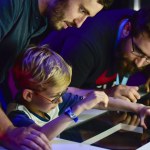EXTRA, the marketplace for scientific touring exhibitions.
Luminopolis is a learned city that has crystallized all the knowledge about light.
What is light? How does it give rhythm to our daily life? How do we share it? Alone or preferably in teams, the participants have a specific number of riddles to solve in order to unlock the exit door of the City of Lights. But they only have one hour. Tick tock tick tock...time is running out, the stopwatch is going crazy! Will they be able to get out in time? See you in Luminopolis!
The objectives :
- To apprehend the multiple aspects of light: scientific, technical, sociological, aesthetic, artistic and poetic.
- To discover the link between light and life.
- To reflect on the importance of light in our societies.
- To link scientific and artistic culture around the theme of light.
- To collaborate in solving enigmas.
The puzzles are all based on four main themes around light:
- What is light? Light is undulatory or corpuscular. It can be visible or invisible. It can be coloured or colourless. It reflects and refracts...
- What does light do to me? Light makes it possible to see, but not only! It can change our behaviour, injure us, heal us, etc. It also gives rhythm to our lives: it regulates our days and seasons.
- How does light bring us together? Places of sharing, gathering and exchange are often associated with light: lantern vigils, fireworks, fire in the fireplace...From the discovery of fire to the generalisation of public lighting, light has considerably influenced and even structured our societies. Like our starry sky, light is also a common good that must be protected by raising awareness of the harmful effects of light pollution.
- Does light allow us to be alive? Light has played a crucial role in the evolution of species. When the first photosynthetic bacteria appeared, light became one of the "foods" of living things. Today, plants and animals know how to use light to breathe, to be seen or, on the contrary, to hide, to reproduce and to move around.
Each enigma has its own principle of resolution based on a range of reasoning and various manipulations (matching of items, association of ideas, deduction by elimination, resolution by iterations, action of mechanisms...). The puzzles are classified in 3 levels of difficulty and are freely accessible whatever the chosen route and at any time during the visit. The answers to the riddles are words and must be compiled in the team's dashboard (using the RFID plate) to advance in the escape game.
At the beginning of the visit the teams of visitors choose their route and will have to solve the number of riddles determined by their choice.
The Master of Luminopolis, who welcomes them, gives them an engraved plaque equipped with an RFID chip corresponding to the chosen colour.
This plate, connected to the Navinum server designed by Cap Sciences, allows them to :
- Choose the level of difficulty of their course
- Specify the number of players in the team
- Choose the language (French or English)
- Record all the visit data (success, failure, photo taking, stopwatch...)
- Activate the puzzles and disconnect from them, causing the module to be reset for the next visitor
- Consult their dashboard through different screens equipped with RFID readers, placed in the exhibition. The dashboard allows you to see the time remaining, the number of words found and the number of errors, to enter new words and to consult clues
- Generate the scorecard at the end of the visit.
There are 3 possible courses corresponding to 3 levels of difficulty:
Luminous course = easy
From 6 years old
Objective: find 10 words
5 possible errors
Brilliant Course = intermediate
From 12 years old
Objective: find 14 words
3 possible errors
Flamboyant course = difficult
From 16 years old
Objective: find 18 words
1 possible error
The levels of the puzzles are repeated in the exhibition by logos in each colour on all the modules. However, whatever the level of difficulty indicated by the logos, each team, regardless of the route chosen at the beginning of the visit, has the possibility of solving the riddle presented.
At any time, the teams can, with their plaque, consult clues on their dashboard or ask for help from the Luminopolis Masters who criss-cross the exhibition.
After one hour, teams who have solved the number of puzzles provided will be given a code to enter at the exit terminal. They will be able to access the "Debriefing Zone" and take stock of their visit experience. Those who have not fulfilled their objective will not be able to leave the exhibition...through the big door! They will have to go out through another door, the losers' door, and maybe try their luck again!














